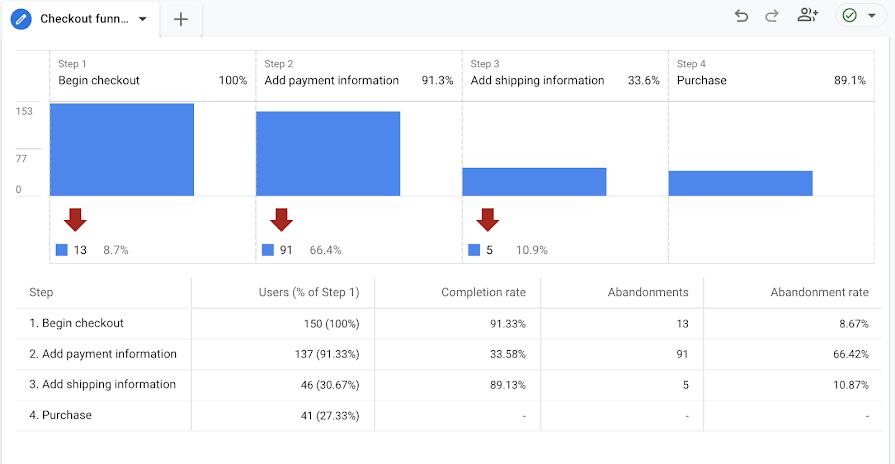What is a Conversion goal
A conversion goal is a specific action that you want visitors to take—whether it’s making a purchase, subscribing, or filling a form. A well-structured conversion goal roadmap is a compass guiding website success
This concept not only measures online effectiveness but also reveals valuable insights into user behavior. We will uncover everything you need to know to create a successful conversion goal roadmap in this article, which makes your efforts purposeful and in tune with your business goals.
Why are conversion goals important
Conversion goals are the backbone of online success for businesses. More than just metrics, they define the actions visitors should take on a website. These goals are crucial for measuring how well a business engages its audience. Here are some of the benefits of having a clear, well-structured conversion goal roadmap:
- Measurable Success: Clear goals offer measurable benchmarks for website success.
- Strategic Guidance: A roadmap aligns your business strategies with objectives.
- Improved User Experience: Goals enhance the visitor’s journey for a better experience.
- Data-Driven Insights: Generate valuable data for informed decision-making.
- Optimized Marketing: Tailor efforts to drive specific actions, increasing efficiency.
- Adaptability: Easily adapt to changing trends and user preferences.
- Enhanced Focus: Keep teams focused on priority actions, improving productivity.
- Resource Allocation: Allocate resources more effectively based on goal priorities.
- Competitive Edge: Position the business competitively for optimal user engagement.
Setting the right conversion goals is important because they provide stability and direction, ensuring your business stays on the right track and is always heading towards the north star goal without straying off the path.
Conversion goal hierarchy – Mirco conversions and Macro conversions
What are Macro conversions
Macro conversions are the main goal of your business and website, this goal is often related to revenue for most businesses. These are completions of highly valuable actions taken by visitors, actions that often align closely with your business goals. For example:
- If you own an ecommerce store, a completed purchase is a macro-conversion.
- For a subscription-based service, a new paid subscription is considered a macro-conversion.
- If your business revolves around generating leads for sales, a macro-conversion occurs when a lead form is successfully submitted.
What are Micro conversions
Micro conversions refer to the smaller, incremental actions that users take on a website, often leading to the ultimate macro conversion or primary goal. Unlike macro conversions, which typically involve major outcomes like making a purchase or completing a form, micro conversions are subtle but significant steps in the user journey. These can include actions such as:
- Signing up for a newsletter
- Clicking on a product
- Adding items to a shopping cart
- Watching an explainer video
- Filling out a contact form
There are numerous granular micro-conversions you can track. Some of them are actions leading up to the macro-conversion goal, while others seem not that directly related to the final goal. These micro-conversions reveal valuable insights into user behavior, enabling you to optimize your strategies and enhance the overall user experience. Recognizing the significance of these smaller actions is key to refining website performance and guiding users seamlessly toward the ultimate conversion goal.
How do they tie together?
To build a strong conversion roadmap, blend macro (like sales) and micro (such as newsletter sign-ups) goals. Macro goals guide overall success, while micro goals act as steps towards them. This approach tailors strategies, improves user experience, and optimizes conversion pathways, providing a comprehensive guide for achieving online objectives. Here’s an example of an Ecommerce site’s conversion goal roadmap incorporating both macro and micro conversions:
Macro Conversion Goal: Purchase
Micro Conversion 1: Visit the product pages
Micro Conversion 2: Sign up for price alerts on favorite products
Micro Conversion 3: Add a product to the shopping cart
Micro Conversion 4: Proceed to checkout
Micro Conversion 5: Create an account during checkout

Types of conversions by industry
By tailoring conversion goals to specific industries, businesses can create focused strategies that align with the unique needs and behaviors of their target audiences.
Below are examples of conversion goals tailored to specific industries, each highlighting unique objectives based on industry characteristics:
1. E-commerce – An online store that offers products for users to buy.
Macro Conversion Goal: Purchase.
For e-commerce sites, the main goal is straightforward: drive product sales. The focus is on turning website visitors into customers by ensuring a smooth shopping experience, optimizing product pages, and making the checkout process efficient. The ultimate aim is to increase completed transactions and generate revenue for the business.
- Micro Conversion 1: Explore product categories and features
- Micro Conversion 2: Add items to the wishlist for future consideration
- Micro Conversion 3: Sign up for personalized product recommendations

Ensure that your macro goal’s call-to-action (CTA) is highly visible with strong contrast and placed above the fold on all devices.
An example for a standard E-commerce store:

2. SaaS – Software as a Service
Macro Conversion Goal: Subscription or paid upgrade.
For SaaS companies, the key goal centers on subscriptions and paid upgrades. The aim is to turn website or app visitors into paying customers by highlighting the software’s value, offering trials or demos, and persuading users to subscribe or choose a premium upgrade. The ultimate objective is to grow the user base and revenue through recurring subscriptions and enhanced service options.
- Micro Conversion 1: Watch demo videos for software features
- Micro Conversion 2: Download a free trial or access a limited version
- Micro Conversion 3: Attend a live webinar on product functionalities
3. Lead generation – An online platform designed to attract potential customers and turn them into leads.
Macro Conversion Goal: Lead Capture/lead form submission
The primary objective for Lead Gen sites is to obtain contact information and relevant details from visitors who have shown interest in the products or services offered.
- Micro Conversion 1: Newsletter Sign-ups
- Micro Conversion 2: Content Downloads
- Micro Conversion 3: Social Media Engagement
4. Content/Media – A site that publishes and shares informational or personal content.
Macro Conversion Goal: Audience Growth or subscription to paid content
Content sites usually focus on expanding the overall reach of the audience or/and encouraging a portion of that audience to subscribe and pay for premium content.
- Micro Conversion 1: Page views
- Micro Conversion 2: Comments
- Micro Conversion 3: Social media shares

You don’t need to be a media company to include social media micro goals on your site! Nowadays, any business can leverage social media engagement to boost influence and expand reach.
Start adding these to your pages if you haven’t already:
5. E-learning platforms – Websites that offer courses, lectures, and educational content.
Macro Conversion Goal: Enrollment
A profitable education site usually aims to get visitors to register or sign up for courses, programs, or educational offerings provided by the website.
- Micro Conversion 1: Watch introduction videos or free video content
- Micro Conversion 2: Download course syllabi and curriculum details
- Micro Conversion 3: Sign up for a webinar on career prospects with the program
Types of conversions for common platforms
In the context of marketing tools and platforms like Google Analytics and Google Ads, as well as in the realm of A/B testing tools, “conversion goals” refer to slightly different concepts. Let’s explore these distinctions:
Conversion Goals in Marketing Platforms (like Google Analytics & Google Ads)
Imagine your website as a bustling marketplace. In this scenario, the “conversion goals” within tools like Google Analytics and Google Ads can be likened to the checkpoints you set up. These checkpoints may include:
- Page views
- Transactions
- User visited a specific page
- User spent a certain amount of time on a page
- Custom events set up by you, such as add to carts, form submission etc
Here’s an example of a checkout funnel in Google Analytics:

Such platforms grant a panoramic view, capturing these checkpoints and quantifying the effectiveness of your marketing strategy. Once you’ve defined a conversion goal in Google Analytics, the platform will then track how often users complete that action. This allows businesses to gauge the effectiveness of their site and marketing efforts.
In Google Ads, conversion tracking provides insights into what happens after a user interacts with your ads—whether they made a purchase, signed up for a newsletter, called your business, or downloaded an app. Setting up conversion actions in Google Ads helps advertisers understand the return on investment (ROI) and allocate budget efficiently based on what’s driving results.
Conversion Goals in A/B Testing Platforms
Now, picture you’re refining the layout of a stall within your marketplace. You’re torn between two designs, unsure which will attract more customers. This is where A/B testing tools come into play. In this context, “conversion goals” refer to the metrics or outcomes that will be used to judge the success of one variant over another. For instance, if you’re testing two different landing page designs, your conversion goal might be:
- The number of users who click a particular button
- The number of users who complete a sign-up form
- Average order value or revenue per visitor
Unlike the broader vista provided by Google’s tools, A/B testing narrows the lens, concentrating on granular shifts and their immediate ramifications. The chosen conversion goal provides a quantifiable way to compare the variants in an A/B test, and thus helps businesses make informed decisions about which version of content or design is more effective.
Conversion goals in marketing analytics vs A/B testing:
While both marketing platforms and A/B testing tools focus on “conversion goals,” they approach them differently. Marketing analytics tools provide a broad overview, measuring the overall performance of a website or ad campaign. On the other hand, A/B testing tools determine which test variation leads to the highest conversion rate, helping businesses optimize their content, design, or user experience to achieve better results.
To encapsulate, “conversion goals” remain a pivotal compass, guiding marketers across various digital terrains. However, the vantage point from which they are observed and harnessed differs, creating a multifaceted and enriched marketing landscape.
How to create conversion goals for your business
- Begin with a Deep Dive – understand your business:
First and foremost, dive into the crux of your business. What’s the core purpose? Is it selling artisan coffee or perhaps offering consultancy services? Recognize the essential activities that directly impact your bottom line.
- Trace the Customer Journey:
Map out your customer’s journey from first contact to final purchase (or other key actions). Understand the steps they take – from awareness, to consideration, to the final decision.
- Recognize Key Touchpoints:
Identify pivotal moments or interactions where your customers make significant decisions. Is it a newsletter sign-up that nudges them? Or a product demo that seals the deal?
- Prioritize Tangible Actions:
With your key touchpoints in hand, determine tangible actions customers can take. Maybe it’s scheduling a callback, adding a product to the cart, or downloading an eBook.
- Frame Your Goals SMARTly:
Craft goals that are Specific, Measurable, Achievable, Relevant, and Time-bound. Instead of “Get more sales”, aim for “Increase online sales by 15% in the next quarter”.
- Integrate with Analytics:
Use platforms like Google Analytics or other bespoke tools to track these goals. Monitor how often these actions happen and identify patterns.
- Stay Fluid and Adaptable:
The digital landscape changes rapidly. What worked six months ago might be obsolete today. Regularly revisit and revise your conversion goals to stay in sync with evolving business needs.
- Celebrate and Reassess:
When you hit a goal, celebrate! But after the confetti settles, sit down to understand why it was achieved. Likewise, if a goal falls short, scrutinize the reasons and adapt your strategies.
In Summary, crafting conversion goals isn’t a one-size-fits-all exercise. It requires a deep understanding of your business, an analysis of your customers’ behavior, and the agility to adapt to ever-shifting landscapes. Tailor your goals to mirror what genuinely drives your business forward, and you’ll lay a foundation for success.
Pro tips and best practices
Laying the Groundwork
- Holistic Visioning: Always maintain a clear vision of your ultimate goal. A skewed focus can lead to misleading metrics. For instance, consistently offering discounts might lift your conversion rate (CVR), yet simultaneously, your revenue could plummet.
- Segmentation Strategy: Understand and segment your audience. Tailored roadmaps for different segments can create more precise and effective conversion funnels.
- Dynamic Adjustments: As you plot your roadmap, embrace the need for change. The digital world isn’t static, and neither should your strategies be.
Mastering Landing Page Best Practices
- Concise Value Proposition: Your landing page headline should succinctly convey your offering’s unique value. A visitor should immediately grasp why they should engage.
- Visual Magnetism: Employ compelling imagery and design that resonates with your target demographic. Visual coherence not only looks professional but also instills trust.
- Clear CTA: Every landing page must have a clear call to action (CTA). Ensure it stands out and is unambiguous. Whether it’s “Get a Free Quote” or “Download Now”, clarity propels action.
- Mobile Optimization: With an increasing number of users accessing sites via mobile, ensuring your landing page is responsive and mobile-friendly isn’t optional—it’s essential.
- Fast Load Times: A sluggish landing page can deter potential conversions. Prioritize speedy load times to maintain user interest and engagement.
- Trust Indicators: Showcase customer testimonials, reviews, or industry certifications. These elements can significantly enhance credibility.
- Limit Distractions: Avoid overwhelming visitors with excessive links or information. A focused path guides them smoothly towards conversion.
Progress and Adaptation
- Frequent Testing: Regularly A/B test elements on your landing page. From CTA buttons to images, every component’s performance should be assessed and optimized.
- Feedback Loop: Create a mechanism to gather user feedback. Direct insights can be invaluable in refining your conversion roadmap.
- Holistic Analysis: Beyond just conversion rates, examine other metrics like Average Order Value or Customer Lifetime Value. This broader perspective ensures well-rounded strategies.
In Conclusion: Crafting a successful conversion goal roadmap necessitates a meticulous blend of strategic foresight, user understanding, and continuous evolution. By intertwining these principles with landing page best practices, you’re well poised to drive meaningful and profitable customer actions.

